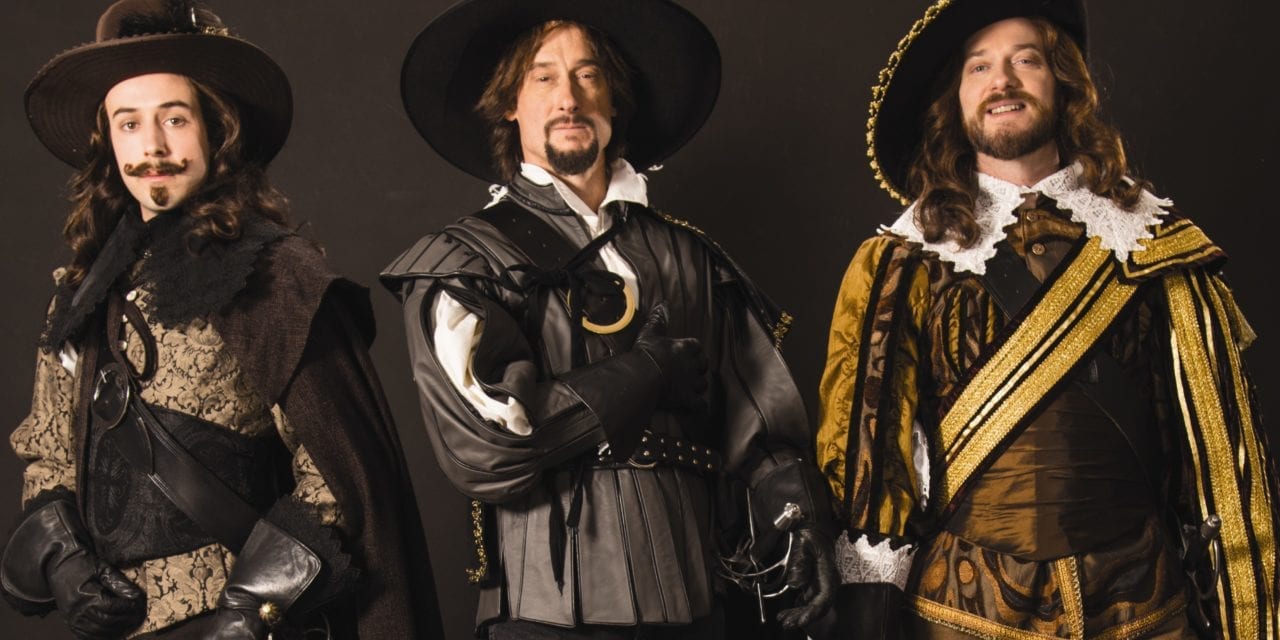CEDAR CITY — As he reaches adulthood, a countryman named D’Artagnan leaves home with the aspiration of becoming a musketeer. Luigi Sottile plays D’Artagnan in The Three Musketeers at this summer’s Utah Shakespeare Festival, and he establishes his character as a proud and passionate young man with potential to do good in contrast to the apathetic existing musketeers (Athos, Porthos, and Aramis). After he inadvertently offends each of them, and then befriends them, D’Artagnan seems to invigorate the musketeers a bit. I dared to hope that these four together would be something worth admiring; but sadly, this was not the case.

Show closes September 9, 2016.
Although based on an Alexandre Dumas novel, Ken Ludwig’s unremarkable script for The Three Musketeers has a foolish plot and disjointed dialogue. Cardinal Richelieu (played by Peter Lohnes) and King Louis XIII (played by Ben Livingston) are at odds because the Cardinal wants to control the kingdom. The Cardinal has a plan to expose Queen Anne’s affair, shaming her, so he can more easily influence the King. Hearing this news from the Cardinal, the King suddenly trusts him and they team up to catch her in her lie. And the Musketeers, who have sworn to serve the King, join D’Artagnan to deceive him instead. Why? Because D’Artagnan met a girl. And even after the Cardinal’s plan fails, the story inexplicably continues.
In addition to an unorganized script, it seemed that director B. J. Jones couldn’t decide what he wanted this play to be. For example, when the musketeers play a prank on the Cardinal, in one of the first scenes of the play, I tried to accept and maintain the mindset that this would be a comedic play, a notion reinforced by a villain dressed as a pirate and fight scenes forcefully accompanied by intense music. At other points, the musketeers casually put on their gloves before a fight, joke about being religious, and obsess over their appearance. These traits were amusing. However, when a completely devastated D’Artagnan cries over Constance’s death without almost no onstage development of their relationship, I didn’t know how to reconcile the frivolity of this production with the attempts at sincerity; it almost felt random. In the final scene, as D’Artagnan joins the Musketeers, he is encouraged to have “Courage, humility, and honor,” and most of all, to defend the King. If this had been a play about these themes, or if the Musketeers had at least kept that last essential charge, the production might have been satisfying.

A scene from the Utah Shakespeare Festival’s 2016 production of The Three Musketeers. (Photo by Karl Hugh. Copyright Utah Shakespeare Festival 2016.)
Happily, the costumes (by David Kay Mickelsen) and wigs looked good on each actor, and they helped to set the characters apart. The King and Queen, dressed in white and gold, wore the best costumes in the play. Their striking wigs and bow-decked shoes made it clear that they were elite, even overtly so. The Cardinal was a wonderful contrast in red. And I loved the details that Mickelsen included in each Musketeer’s ensemble. These costumes provided much needed visual interest against the blue patterned walls of Scott Davis’s minimalist set.
Sceri Sioux Ivers, as D’Artagnan’s little sister Sabine, is an asset to this production. She has the stubbornness and energy of a younger sibling, and she added interest into each of her scenes. Her pursuit of Tasso Feldman’s Aramis, and his attempts to dissuade her, created a fun dynamic. Although her interpretation of drunkenness was incredibly awkward, I found no other fault in Ivers. Indeed, I wish she had been onstage more. Livingston was funny in his indignant, childish portrayal of the king, but those humorous mannerisms and dialect became tedious in the second act. Sottile, as D’Artagnan, was also much better earlier on in the play. Kim Martin-Cotten played her four roles (D’Artagnan’s mother, Queen Anne, Mother Superiod, and an abbess) nicely, showing her versatility. Melinda Parrett was devious as Milady, and Lohnes’s portrayal of the Cardinal, with his creepy facial hair, was excellently intimidating and appropriate for an antagonist. It is a pity that Ludwig gave each of these actors such unsubstantial characters.
At times silly and overdone, and at others almost sincere, the ambivalent tone of this production kept me from liking either quality very much. Ludwig’s script was disappointing, and so was Jones’s execution. Sure, the Musketeers were likeable, and there’s the sword fighting by David Woolley to consider. But, aside from the lovely costumes and the admirable performance of the actors the Utah Shakespeare Festival’s The Three Musketeers is simply mediocre.




